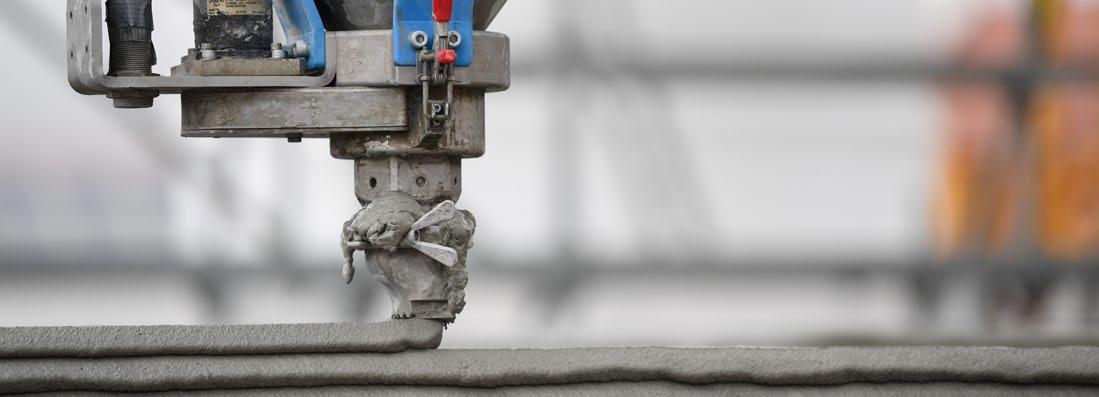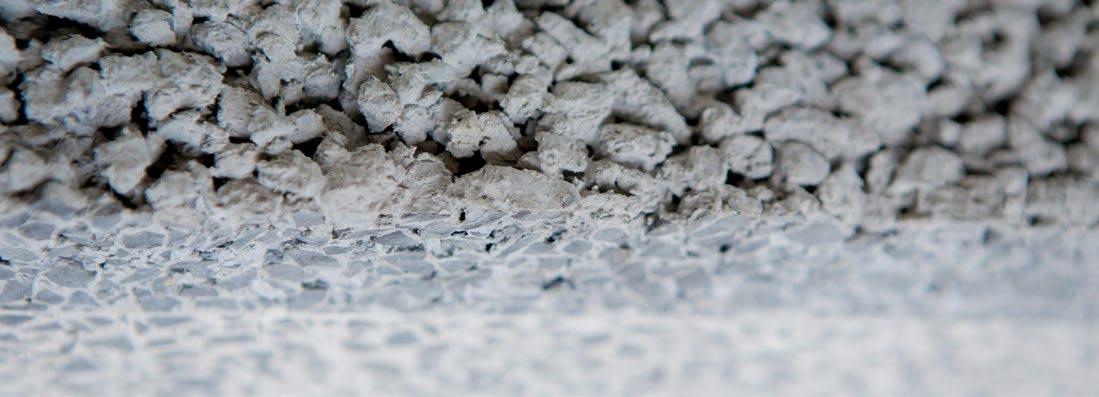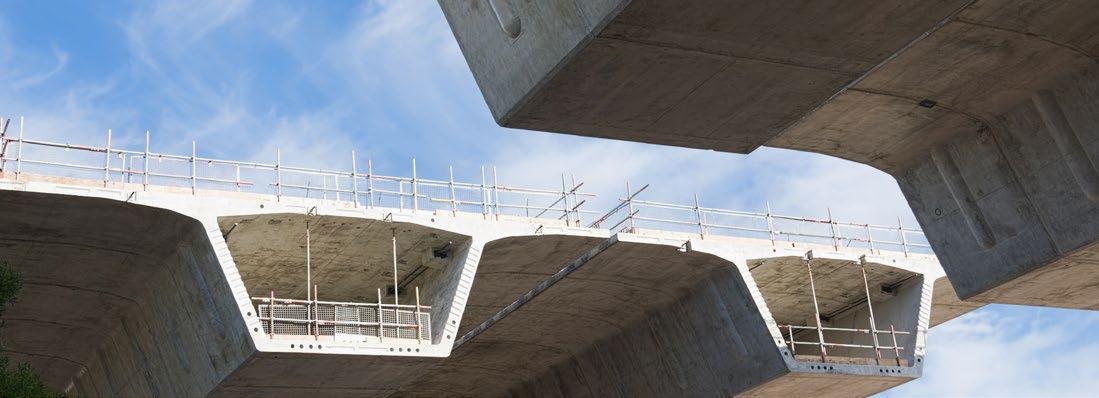
19 minute read
9 Future R&D priorities and projects
In order to further develop low emissions cement and concrete, the entire infrastructure and construction value chain from clinker, cement and concrete to the construction site, the structure itself, the re-use of components and the recovery of construction waste have to be considered. Not all of the technologies required have yet been developed to such an extent that immediate application is possible. Therefore, ten areas of innovation were identified with regard to national and international sources of information and interviews with experts. These areas define future R&D priorities and projects – see Table 4.
Table 4: Innovation areas along the value chain
Pathway Description of the contribution
Clinker Alternative fuels with biomass Cement companies, CSIRO, universities and related research organisations – both domestic and international, federal and state targeted programs.
Cement, Concrete Carbon capture
Green hydrogen as a fuel and for CO2 utilisation Energy efficiency
Beneficiation of fly ash to be used as SCM Calix, CO2CRC, HILTCRC, ECRA, CarbonNet and other providers. Future Fuels CRC, H2TCA, H2council, ECRA and inter-governmental and research partnerships. Cement companies, HILT CRC, Race for 2030 CRC, CESMII and its partners. SmartCrete CRC, Federal and State research organisations, governments and related bodies.
Database on low carbon cement and concrete SmartCrete CRC, Race for 2030 CRC, L3C, universities and related research and government organisations – both domestic and international.
Cement, Concrete, Construction Specification of concrete durability by performance
Potentials of additive manufacturing and digitalisation SmartCrete CRC, fib*, RILEM*, universities and related government and research organisations – both domestic and international. SmartCrete CRC, ETH Zurich, CSIRO, RILEM*, universities and related government and research organisations – both domestic and international.
Recarbonation – potentials regards natural CO2 uptake in Australia and further active CO2 treatment technologies
SmartCrete CRC, fib*, RILEM*, universities and related government and research organisations – both domestic and international. Construction Resource-efficient design principles SmartCrete CRC, Race for 2030 CRC, fib*, University of Stuttgart – formerly Werner Sobek, universities and related government and research organisations – both domestic and international.
TRL
< 2025
<2025
< 2025
< 2025
< 2025
< 2025
< 2025
> 2025
<2025
> 2025
* fib and RILEM are research and pre-normative networks themselves through which multiple research contacts can be generated ** The list of potential partners is not exhaustive. There are other research networks and/or universities which can provide input to the respective innovation area.
Details of each innovation area are provided on the following pages in the form of a brief profile describing the starting point, the aim and the main item and work packages respectively.
Alternative Fuels with Biomass
Alternative fuels with biomass provide positive impact on CO2 emissions and circular economy
Starting Point
■ Australia has a high potential to further substitute fossil fuels with alternative waste solutions. ■ The use of alternative fuel is currently low compared with other countries and below what is technically possible. Clinker burning provides inherently good conditions for co-processing of waste. ■ Future waste options are likely to be different from today’s waste .
Aim of the (joint) research project
■ Show potential of cement plants to contribute to local waste management. ■ Encourage the development and implementation of future fuel concepts based on defined waste streams.
Work packages
■ Show best practices: seminar, workshop, conferences. ■ Engage local and regional stakeholders. ■ Highlight and potentially test modern combustion technologies. A thermal energy substitution rate (TSR) of 18 per cent in Australia is still relatively low compared to other countries, however, has been increasing steadily. With long residence times at very high temperatures and the incorporation of fuel ashes in the final product, the clinker burning process presents unparalleled conditions for the co-processing of waste. The continuous technological evolution of industrial processes and the increasing societal pressure towards higher recycling rates will drive the type of waste streams available for co-processing in the future.
The role that cement plants can play in local waste management needs to be further assessed. The availability of alternative fuels and/or favourable economic conditions has to determined (e.g. price of fossil fuels compared to alternative fuels and CO2 costs) to enable a sustainable growth of the TSR in the future. Available waste streams need to be identified and characterised. Adequate pre-processing technologies have to be selected to enable the conversion of waste into suitable alternative fuels.
Seminars, workshops or conferences targeted at specific stakeholders (technical, local communities, etc.) for dissemination of the best practices in pre-processing and co-processing of alternative fuels should be organised to increase the awareness of the societal, environmental and technical benefits associated with this technology. The use of biomass at high TSR requires the deployment of modern combustion technologies which need to be assessed and tested.
Carbon capture
Carbon capture technologies and pathways towards storage and utilisation

Starting Point
■ Carbon capture technologies ready for testing and implementation. ■ High CAPEX and OPEX. ■ First demonstration/industrial scale capture, storage and/or utilisation projects still to be realised. ■ Australia can provide relevant CO2 infrastructure, storage sites. ■ Australia can provide H2 for transforming CO2.
Aim of the (joint) research project
■ Integrate capture in cement production into national
CCUS plan. ■ Produce the first CO2 free clinker in Australia. ■ Show costs and impact of competitiveness.
Work packages
■ Develop a feasibility scenario for carbon capture in the
Australian cement industry. ■ Apply carbon capture on demonstration scale and then scale to commercial phase in the future. ■ Test indirect calcination (CALIX) to integrate domestic technology. ■ Study the synergies with H2 production at site of cement plant. Carbon capture technologies are currently available for testing and implementation at different TRLs. The first CCUS demonstration projects at industrial/ semi-industrial scale covering the whole CO2 value chain are expected in the present decade. However, carbon capture is in general also linked to high CAPEX and OPEX. Captured CO2 combined with H2 can be utilised in the production of synthetic fuels. Several potential CO2 storage sites in Australia have already been identified.
The project aims to investigate and demonstrate CCUS in semi-industrial scale adapted to the specificities of the Australian cement industry and ultimately produce its first CO2 free clinker. In addition, it aims to inform and develop trust amongst all stakeholders and prove the value of integrating carbon capture in cement manufacturing into the Australian CCUS plan. Synergies with other local industrial partners needs to be investigated in order to identify new business opportunities, increase the value of CO2 and reduce costs (e.g. creation of a CCUS cluster).
A feasibility study taking local specificities into account can provide the launch pad for the demonstration of CCUS in Australia. The production of H2 in a cement plant with electrolysers to substitute fossil fuels or convert CO2 into a product with more added value shall be studied. Possible synergies with local carbon capture technology providers (e.g. CALIX) need to be further assessed.
Green hydrogen as a fuel and for CO2 utilisation
Synergies between H2, O2 and CO2 generation

Starting Point
■ Green hydrogen to play an important role in energy transition and decarbonising heavy industries. ■ Australia well positioned in H2 generation. ■ Hydrogen infrastructure requires further development. ■ International agreement in place.
Aim of the (joint) research project
■ Enable green H2 as a fuel in clinker burning. ■ Show synergies between H2, O2 and CO2 generation.
Work packages
■ Develop framework of H2 value chain. ■ Identify the role of the cement industry. ■ Test H2 generation and simultaneous use of oxygen in oxyfuel and calcium looping technologies. The use of green H2 is seen as a promising vector to reduce CO2 emissions in energy-intensive industries, as only H2O is generated from its combustion. The availability of renewable and fossil energy resources positions Australia well in the production of affordable green H2, however, investment and new infrastructure will be required.
The combustion of H2 is yet to be tested in the cement industry. Prohibitive costs, scarce availability as well as safety and logistic/handling issues have always kept H2 out of the list of potential “alternative fuels” to date. How exactly H2 might impact on cement manufacturing process is yet to be determined. Demonstration of the technology is crucial to aspire a wider dissemination in Australia and overseas by 2050. The electrolysis of water on-site can generate O2 as a by-product. How O2 can be used both for flame enrichment and, thus, to increase TSR in the main burner, or as substitute of air in some carbon capture technologies, needs to be investigated.
H2 might be used in the future as fuel or feedstock in several industries. Thus, a national/regional regulation framework needs to be developed to provide the necessary guidance and confidence to all emerging players and investors in the H2 value chain. The role of the cement industry will much depend on the envisaged demand of H2 and if its generation can be decentralised (electrolysers on-site). The techno-economic and environmental benefits of carbon capture combined with H2 and O2 generated on-site have to be determined. Valuable data can be collected if the technology can be tested at plant level.
Energy efficiency
Increasing energy efficiency to the highest level

Starting Point
■ Both thermal and electrical energy efficiency in cement plants are at a very high level. ■ Increasing energy efficiency to the highest level – even if electricity is fully decarbonised or CO2 from clinker manufacturing is captured.
Aim of the (joint) research project
■ Show potential of IoT, smart sensors, artificial intelligence and advanced control in the cement industry, and in particular their effect on energy efficiency – both electrically and thermally.
Work packages
■ Search for existing or develop new predictive models which include data analysis based on data collection with smart sensors and meters. ■ Study the application of smart (and lean) manufacturing strategies in cement production to show potential to automate the process and to lower the overall energy demand – both electrically and thermally. Since energy constitutes a high share of costs in the production of cement, cement companies have always been striving to lower the demand for electricity and fuels. Further improvements in energy efficiency will lower the need for both decarbonised electricity and CCUS. To optimise and automate the production process IoT (Internet of Things), smart sensors, artificial intelligence and advanced control systems should be increasingly applied in the cement industry as they will also have an impact on energy efficiency.
The RACE for 2030 CRC has been involved in the CESMII research project, in which smart manufacturing has achieved more than 15 per cent improvement compared to previously with glass kilns. The gains with CESMII in fuel efficiency in the glass industry were achieved using smart sensors and AI for combustion controls, which is the starting point for a major part of the work which the consortium is now undertaking in modelling the cement production process.
Predictive modelling is already today an integrated part of the cement production process. Less kiln stops through predictive maintenance, combustion control assisted by artificial intelligence, and predicting the cement performance based on the analysis of laboratory data are increasingly being implemented. The work packages will take advantage of existing experience and will show existing potential for the application of smart manufacturing and its role in increasing energy efficiency.
Beneficiation of fly ash
Fly ash which has been stockpiled can qualify as SCMs – once its quality has been assured

Starting Point
■ Decarbonisation of the power sector will likely lead to less fly ash production in the future. ■ In Australia, coal combustion products (CCP) are stockpiled.
Aim of the (joint) research project
■ Make stockpiled fly ash available in high amounts as
SCM in cement and/or concrete. ■ Show the potential (volume and quality-wise) of
Australian CCP which are stockpiled. ■ Apply methods of beneficiation and check its technical and economical relevance.
Work packages
■ Make stockpiled fly ash available in high amounts as
SCMs in cement and/or concrete. ■ Show the potential (volume and quality-wise) of
Australian CCP which are stockpiled. ■ Apply methods of beneficiation and check its technical and economical relevance. In Australia, about 500 million tonnes of Coal Combustion Products like fly ash are stockpiled, some of which can be used as SCMs in cement and/or concrete. Fly ash must be sorted and the quality of suitable fractions must be checked and improved (beneficiation).
The quantity of the fly ash as a fraction of the total CCP needs to be evaluated. In addition, its quality, of which the unburnt carbon and chloride content are the most important indicators, must be determined. Clear techno-economic indicators are required as a basis for nearterm decisions on to which degree fly ash can be recovered from existing volumes. Several techniques should be evaluated – always against the background of the final quality of the processed fly ash, the overall recovery rate and the costs entailed. Since most of the CCP have been kept wet to avoid fugitive dust emissions, drying efforts must be included in the recovery and beneficiation process. A special focus should be given to the chloride content of fly ashes which are ponded in saline waters.
The work packages could be jointly worked on with experts from respective research organisations, coal producers and technology providers. A techno-economic analysis is needed to ensure proper decisions for scaling up the findings of this project.
A tool to develop trust in low-carbon products from all stakeholders

Starting Point
■ Cement and concrete with a low clinker-binder factor are key pathways to further reduce CO2 emissions in the concrete sector. ■ Insufficient database on the performance.
Aim of the (joint) research project
■ Development of a comprehensive database on the properties of low-carbon cement and concrete.
Work packages
■ Production of clinker-efficient cement and concrete (lab/plant). ■ (Lab)Properties of clinker-efficient cement and concrete: ■ cement properties ■ fresh and hardened concrete properties ■ Field site properties of clinker-efficient concrete. Cement and concrete with a low clinker-binder factor are key pathways to further reduce CO2 emissions in the concrete sector. Within the Australian concrete standard, only certain cements or types of cement are mentioned and are therefore permitted, and the durability-performance of new cements and binders would need sufficient proof e. g. by testing. Therefore, the database on the durability performance of such cements and concretes should be improved.
The development of a comprehensive database on the properties of low-carbon cement and concrete is essential as all stakeholders, clients, designers, contractors and authorities will help to develop trust that these cements and concretes will also produce high-quality, durable and therefore sustainable concrete structures. The project is linked to the innovation area “Specification of concrete durability by performance tests and service life considerations”, where the correlation between lab-performance and the performance of concrete in the building is further investigated and established.
Clinker-efficient cements and concretes are to be produced on a lab-scale and in the plant. Cement properties as well as fresh and hardened concrete properties are to be determined for a broad range of cement and concrete compositions. In addition to the innovation area “Specification of concrete durability by performance tests and service life considerations”, field site tests are an essential part of the project.
Performance-based specifications as a contribution to decarbonised and resource-efficient concrete

Starting Point
■ Only certain cements or types of cement permitted today in the Australian concrete standard. ■ Prescriptive specifications by road authorities. ■ Low flexibility to show durability of decarbonised and resource efficient concrete. ■ Performance-based specifications as an option.
Aim of the (joint) research project
■ Sufficient durability of decarbonised and resource-efficient concrete structures through performance-based specifications.
Work packages
■ Investigation on a representative selection of existing structures. ■ Limit states of durability. ■ Test procedures (laboratory, building tests). ■ Classification of resistances, production control and conformity criteria. ■ Acceptance tests / criteria on site / for the building. Only certain cements or types of cement are mentioned and are therefore permitted, and the durability-performance of new cements and binders would need sufficient proof e. g. by testing.
Further, road authorities in Australia usually have prescriptive specifications and therefore a low flexibility to show the durability of decarbonised and resource efficient concrete. Performance-based specifications are an option to effect change.
The project aims at significantly contributing to decarbonised and resource-efficient concrete and at the same time ensuring durability of concrete structures and a sufficient service life through performance-based specifications.
The correlation between the result of performance tests under laboratory conditions and the performance in the building or structure should be investigated. This should also include the knowledge of how the results of a concrete or nominally identical concrete composition vary under the conditions – for example, in a ready-mixed concrete plant: changes in the constituents, weighing tolerances, moisture of the aggregates etc. The durability of the building must be defined. Is this the point in time of the depassivation of the reinforcement or should the corrosion rate of the reinforcement be considered? The measures of production control and conformity criteria would have to be worked out for the corresponding concretes. Finally, acceptance tests and acceptance criteria on-site and for the building should be developed and defined.
Additive manufacturing (e. g. 3D printing) and digitalisation
What is the contribution to decarbonisation and resource efficiency?

Starting Point
■ The methods of digital production with concrete are currently gaining maturity. ■ What are the potentials for decarbonisation and resource efficiency?
Aim of the (joint) research project
■ Greater use of digital production techniques in concrete construction: positive contribution to decarbonisation and resource efficiency? ■ Advantages and limits of the existing technologies? ■ Future areas of application.
Work packages
■ Required material properties of fresh and hardening concrete. ■ Integration of the reinforcement. ■ Technology-compliant or technology-promoting construction principles and design rules. ■ Potentials for decarbonisation and resource efficiency, e. g. by Life Cycle Assessments (LCA). The topic of digital production with concrete is being developed and evaluated in many places around the globe. A number of practical pilot-scale applications already exist. Some raise tremendous expectations with these technologies in terms of productivity and quality. However, the question of the contribution to decarbonisation and resource efficiency is also open.
The project aims to specifically answer the question of whether a greater use of digital production techniques in concrete construction – beyond the issues of skill shortages and productivity – would also make a positive contribution to the questions of decarbonisation and resource efficiency. Against this background, the advantages and the limits of the existing technologies as well as the future areas of application and the users should be addressed.
A practicable procedure for the definition, adjustment and testing of the required material properties of fresh and hardening concrete should be elaborated. Adequate solutions for the integration of the reinforcement are to be developed. The development of technology-compliant or technology-promoting construction principles and design rules is also important. The future availability of resources in conjunction with the new manufacturing technologies must be taken into account. The potentials for decarbonisation and resource efficiency will be assessed e. g. by Life Cycle Assessments (LCA).
Recarbonation
Potentials for the natural uptake of CO2 in Australia and further active CO2 treatment technologies

Starting Point
■ Hardened concrete takes up CO2. This natural diffusion process is called (re)carbonation. ■ Fresh concrete can also absorb CO2. ■ Active treatment of fresh concrete, concrete elements, secondary aggregates and crushed concrete fines with
CO2 is an option.
Aim of the (joint) research project
■ Demonstrate the potential of fresh concrete to uptake
CO2. ■ Show the impact of carbonation when curing concrete elements in a CO2 enriched atmosphere. ■ What is the influence of (actively) carbonated secondary aggregates and crushed concrete fines on the properties of recycled concrete?
Work packages
■ Calculate CO2 uptake in Australia. ■ Show the impact of a CO2 enriched atmosphere on concrete elements, secondary aggregates and crushed concrete fines. Carbonation is a chemical reaction which transforms calcium hydroxide to calcium carbonate. For this study, the most conservative approach of 20 per cent of process CO2 emissions for recarbonation of hardened concrete was taken into account. Studies on active CO2 processing of fresh concrete and recycled aggregates show further potentials.
The carbonation potentials which are measured and which are documented in the literature should be examinded from an Australian perspective. The potential to develop a method for inclusion under the Emissions Reduction Fund in the future is to be evaluated.
■ Calculate CO2 uptake of mortar and concrete during their service life and after the end of life for the
Australian situation. ■ Demonstrate the potential of fresh concrete to uptake
CO2 and to save cement in concrete. ■ Show the impact a CO2 enriched atmosphere on concrete elements, secondary aggregates and crushed concrete fines.
Resource efficient design principles
A contribution to sustainability at the component and building level

Starting Point
■ Concrete elements subject to bending stress with simple and compact full cross-sections become relatively inefficient with regard to the sustainable use of concrete. ■ Typical examples are ceiling tiles, beams or wall-like slabs, which are used in large amounts.
Aim of the (joint) research project
■ Create the basis for the broad introduction of resource- efficient design methods. ■ Material that is not required is removed.
Work packages
■ Topological optimisation. ■ Material-appropriate control. ■ Inner reinforcement finding. ■ Hollow bodies in panels and walls. In the case of components subject to bending stress, simple and compact full cross-sections become inefficient. Large cross-sectional areas are unused statically. Reinforced concrete structures of this kind primarily support themselves with a typical weight share of around 70 per cent. The traffic load therefore requires 2.5 times its share of the concrete ceiling for taking up the load.
The aim is to create the basis for the broad introduction and application of resource efficient design methods e. g. by the alignment of outer forms and inner reinforcements with the flow of forces. The results are slim, material-saving constructions that largely have axial compressive and tensile stresses.
Modern approaches to topology optimisation are numerically structured and use the finite element method (FEM) as an analysis method. For material-appropriate designs, it is important to include characteristics of the material to be used in the optimisation process. For concrete this means a distinction between compressive and tensile stress in the form-finding process and their prioritisation. Hollow or displacement bodies can reduce the concrete volume used in components such as slabs, walls or shells.





